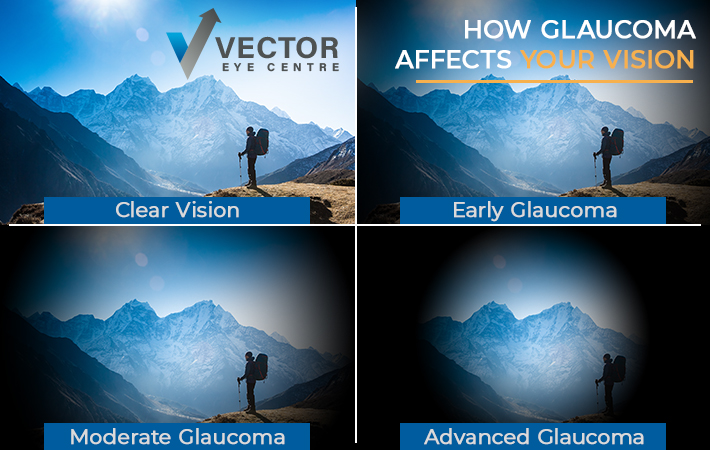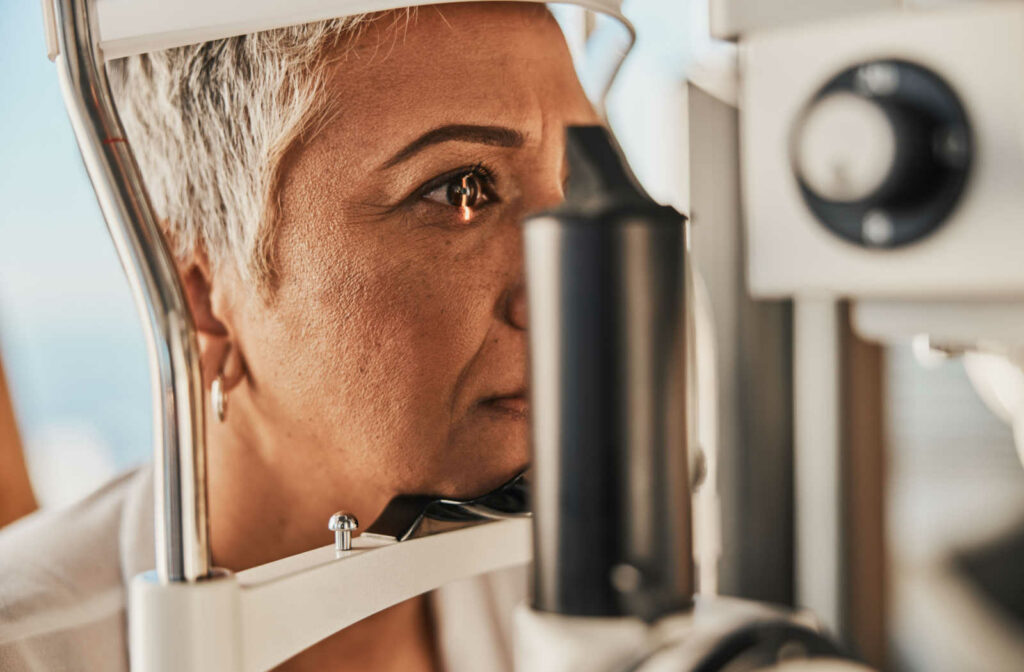Glaucoma is a group of eye diseases that affect the optic nerve and can lead to blindness. There are several types of glaucoma, which each affect your eyes slightly differently. The most common types of glaucoma have no early warning signs, making this condition especially dangerous.
Glaucoma can take years to develop, and those with this condition may not notice any significant change in their vision until it’s advanced. This is because the initial loss of vision primarily affects the side or peripheral vision, while central vision remains relatively unaffected until the disease progresses to later stages.
While glaucoma may be a complex condition, it’s also relatively common among other eye diseases and disorders, affecting more than 450,000 Canadians.
Understanding how glaucoma can affect you and why eye exams are so important is critical for preserving your vision—especially if you are at risk.

What Are the Symptoms of Glaucoma?
Although many types of glaucoma develop without noticeable symptoms, they can lead to different symptoms as they progress, depending on the specific type of glaucoma. Common symptoms include:
- Gradual loss of peripheral vision: Glaucoma often affects peripheral vision first, leading to blind spots.
- Tunnel vision: As the disease advances, loss of peripheral vision results in the perception of seeing through a tunnel.
- Increased sensitivity to light: Some individuals may experience heightened sensitivity to light or glare such as when the intraocular pressure is suddenly elevated.
- Blurred or hazy vision: Vision may appear blurred or hazy, especially in the peripheral areas.
- Difficulty with low-light situations: It may become challenging to see clearly in dim lighting or at night.
- Eye pain or discomfort: In some cases, individuals may experience mild eye pain, headaches, or general eye discomfort.
How Does Glaucoma Cause Vision Loss?
Glaucoma causes vision loss and blindness because it damages the optic nerve. The optic nerve is responsible for sending visual information from your eyes to your brain, so any damage it receives impacts your vision. Depending on the type of glaucoma that you have, specific factors contributing to that damage can vary.
Primary Open-Angle Glaucoma
Primary open-angle glaucoma is most common and accounts for 90% of glaucoma cases. It occurs when the fluid inside your eye does not drain properly through the trabecular meshwork, causing pressure buildup.
Primary open-angle glaucoma often progresses slowly and without symptoms until significant vision loss occurs. Therefore, regular eye exams are essential for early detection and treatment.
Acute Angle-Closure Glaucoma
Acute angle-closure glaucoma is a medical emergency that requires immediate attention. It occurs when your iris (the coloured part of your eye) blocks the eye’s drainage angle, resulting in a sudden increase in IOP.
Symptoms of acute angle-closure glaucoma include severe eye pain, blurred vision, halos around lights, and nausea. If left untreated, this glaucoma can cause rapid and permanent vision loss.
If you believe you are experiencing acute angle-closure glaucoma or you experience any form of rapid vision loss, you should seek care at your nearest emergency medical centre.
Normal-Tension Glaucoma
Normal-tension glaucoma develops when optic nerve damage occurs even though your IOP is within the normal range. The exact cause of this type of glaucoma is unknown, but it is believed to be related to poor blood flow to the optic nerve.
Those with normal-tension glaucoma may experience vision loss in a similar pattern to primary open-angle glaucoma, but they may have a lower risk of developing high IOP. Normal-tension glaucoma can be detected during a comprehensive eye exam.
Secondary Glaucoma
This type of glaucoma develops as a secondary complication of another eye condition or disease, such as cataracts, diabetes, or inflammation. It can occur at any age and progress quickly or slowly, depending on the underlying cause.
An optometrist or ophthalmologist can detect signs of secondary glaucoma during a comprehensive eye exam.
How Do You Treat Glaucoma?
There is no cure for glaucoma, but an early diagnosis and early management can help prevent additional vision loss. Vision loss caused by glaucoma is often permanent, so early detection is crucial for preserving your sight.
Medication
During glaucoma’s early stages, medication can be used to reduce your eye pressure. Medication for glaucoma typically includes eye drops and may consist of a combination of medications or a series of different medications depending on how your eyes respond to treatment.
Surgery
As glaucoma progresses and depending on how your eyes respond to treatment, your eye care team may recommend surgical procedures to help decrease the pressure in your eye and limit the progression of glaucoma.
Selective laser trabeculoplasty (SLT) is a procedure that targets the drainage system of your eye—the trabecular meshwork—to improve the flow of the aqueous humour—the fluid produced by your eye. SLT can be used to treat several forms of open-angle glaucoma.
YAG peripheral iridotomy involves creating a tiny hole in your iris to improve fluid flow in your eye from front to back. YAG peripheral iridotomy is typically used to help patients with acute angle-closure glaucoma.

Who Can Develop Glaucoma?
Glaucoma can affect anyone at any age but is generally more common in those over 60. Other risk factors include:
- A family history of glaucoma
- Eye injuries
- High blood pressure & other cardiovascular conditions
- Diabetes
- Other eye conditions
When Should You See an Eye Doctor?
You should always see your eye doctor for a comprehensive eye exam every 1–2 years.
If you have an existing eye health condition that can increase your risk of developing glaucoma, it is crucial to follow your eye doctor’s recommendations regarding the eye exam frequency and ongoing treatment. At Vector Eye Centre, we’re dedicated to helping patients receive comprehensive support for surgical procedures, glaucoma treatment, and other forms of eye care. Vector eye Centre is an advanced, subspecialty Ophthalmology clinic equipped with state-of-the-art diagnostic equipment to monitor glaucoma. Contact us to learn more about how we can help treat glaucoma to preserve your vision.



